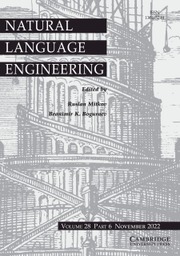Article contents
The Japanese lexical transducer based on stem-suffix style forms
Published online by Cambridge University Press: 01 December 1996
Abstract
A Lexical Transducer (LT) as defined by Karttunen, Kaplan, Zaenen 1992 is a specialized finite state transducer (FST) that relates citation forms of words and their morphological categories to inflected surface forms. Using LTs is advantageous because the same structure and algorithms can be used for morphological analysis (stemming) and generation. Morphological processing (analysis and generation) is computationally faster, and the data for the process can be compacted more tightly than with other methods. The standard way to construct an LT consists of three steps: (1) constructing a simple finite state source lexicon LA which defines all valid canonical citation forms of the language; (2) describing morphological alternations by means of two-level rules, compiling the rules to FSTs, and intersecting them to form a single rule transducer RT; and (3) composing LA and RT.
Information
- Type
- Research Article
- Information
- Copyright
- 1997 Cambridge University Press
- 1
- Cited by

